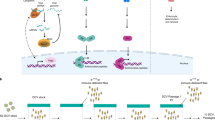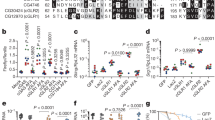Abstract
The fruit fly Drosophila melanogaster is a model system for studying innate immunity, including antiviral host defense. Infection with drosophila C virus triggers a transcriptional response that is dependent in part on the Jak kinase Hopscotch. Here we show that successful infection and killing of drosophila with the insect nodavirus flock house virus was strictly dependent on expression of the viral protein B2, a potent inhibitor of processing of double-stranded RNA mediated by the essential RNA interference factor Dicer. Conversely, flies with a loss-of-function mutation in the gene encoding Dicer-2 (Dcr-2) showed enhanced susceptibility to infection by flock house virus, drosophila C virus and Sindbis virus, members of three different families of RNA viruses. These data demonstrate the importance of RNA interference for controlling virus replication in vivo and establish Dcr-2 as a host susceptibility locus for virus infections.
This is a preview of subscription content, access via your institution
Access options
Subscribe to this journal
Receive 12 print issues and online access
$209.00 per year
only $17.42 per issue
Buy this article
- Purchase on Springer Link
- Instant access to full article PDF
Prices may be subject to local taxes which are calculated during checkout





Similar content being viewed by others
References
Medzhitov, R. & Janeway, C.A., Jr. Decoding the patterns of self and nonself by the innate immune system. Science 296, 298–300 (2002).
Beutler, B. & Rietschel, E.T. Innate immune sensing and its roots: the story of endotoxin. Nat. Rev. Immunol. 3, 169–176 (2003).
Hoffmann, J.A., Kafatos, F.C., Janeway, C.A. & Ezekowitz, R.A. Phylogenetic perspectives in innate immunity. Science 284, 1313–1318 (1999).
Brennan, C.A. & Anderson, K.V. Drosophila: the genetics of innate immune recognition and response. Annu. Rev. Immunol. 22, 457–483 (2004).
Hultmark, D. Drosophila immunity: paths and patterns. Curr. Opin. Immunol. 15, 12–19 (2003).
Hoffmann, J. The immune response of Drosophila. Nature 426, 33–38 (2003).
Cherry, S. & Perrimon, N. Entry is a rate-limiting step for viral infection in a Drosophila melanogaster model of pathogenesis. Nat. Immunol. 5, 81–87 (2004).
Cherry, S. et al. Genome-wide RNAi screen reveals a specific sensitivity of IRES-containing RNA viruses to host translation inhibition. Genes Dev. 19, 445–452 (2005).
Sabatier, L. et al. Pherokine-2 and -3: Two Drosophila molecules related to pheromone/odor-binding proteins induced by viral and bacterial infections. Eur. J. Biochem. 270, 3398–3407 (2003).
Roxstrom-Lindquist, K., Terenius, O. & Faye, I. Parasite-specific immune response in adult Drosophila melanogaster: a genomic study. EMBO Rep. 5, 207–212 (2004).
Dostert, C. et al. The Jak-STAT signaling pathway is required but not sufficient for the antiviral response of drosophila. Nat. Immunol. 6, 946–953 (2005).
Agaisse, H. & Perrimon, N. The roles of JAK/STAT signaling in Drosophila immune responses. Immunol. Rev. 198, 72–82 (2004).
Voinnet, O. Induction and suppression of RNA silencing: insights from viral infections. Nat. Rev. Genet. 6, 206–220 (2005).
Waterhouse, P.M., Wang, M.B. & Lough, T. Gene silencing as an adaptive defence against viruses. Nature 411, 834–842 (2001).
Meister, G. & Tuschl, T. Mechanisms of gene silencing by double-stranded RNA. Nature 431, 343–349 (2004).
Bartel, D.P. MicroRNAs: genomics, biogenesis, mechanism, and function. Cell 116, 281–297 (2004).
Palliser, D. et al. An siRNA-based microbicide protects mice from lethal herpes simplex virus 2 infection. Nature 439, 89–94 (2006).
Tompkins, S.M., Lo, C.Y., Tumpey, T.M. & Epstein, S.L. Protection against lethal influenza virus challenge by RNA interference in vivo. Proc. Natl. Acad. Sci. USA 101, 8682–8686 (2004).
Zhang, W. et al. Inhibition of respiratory syncytial virus infection with intranasal siRNA nanoparticles targeting the viral NS1 gene. Nat. Med. 11, 56–62 (2005).
Ge, Q. et al. Inhibition of influenza virus production in virus-infected mice by RNA interference. Proc. Natl. Acad. Sci. USA 101, 8676–8681 (2004).
Bitko, V., Musiyenko, A., Shulyayeva, O. & Barik, S. Inhibition of respiratory viruses by nasally administered siRNA. Nat. Med. 11, 50–55 (2005).
Li, B.J. et al. Using siRNA in prophylactic and therapeutic regimens against SARS coronavirus in Rhesus macaque. Nat. Med. 11, 944–951 (2005).
Li, W.X. et al. Interferon antagonist proteins of influenza and vaccinia viruses are suppressors of RNA silencing. Proc. Natl. Acad. Sci. USA 101, 1350–1355 (2004).
Li, H., Li, W.X. & Ding, S.W. Induction and suppression of RNA silencing by an animal virus. Science 296, 1319–1321 (2002).
Schneemann, A., Reddy, V. & Johnson, J.E. The structure and function of nodavirus particles: a paradigm for understanding chemical biology. Adv. Virus Res. 50, 381–446 (1998).
Albarino, C.G., Price, B.D., Eckerle, L.D. & Ball, L.A. Characterization and template properties of RNA dimers generated during flock house virus RNA replication. Virology 289, 269–282 (2001).
Lu, R. et al. Animal virus replication and RNAi-mediated antiviral silencing in Caenorhabditis elegans. Nature 436, 1040–1043 (2005).
Chao, J.A. et al. Dual modes of RNA-silencing suppression by Flock House virus protein B2. Nat. Struct. Mol. Biol. 12, 952–957 (2005).
Schott, D.H., Cureton, D.K., Whelan, S.P. & Hunter, C.P. An antiviral role for the RNA interference machinery in Caenorhabditis elegans. Proc. Natl. Acad. Sci. USA 102, 18420–18424 (2005).
Wilkins, C. et al. RNA interference is an antiviral defence mechanism in Caenorhabditis elegans. Nature 436, 1044–1047 (2005).
Franz, A.W. et al. Engineering RNA interference-based resistance to dengue virus type 2 in genetically modified Aedes aegypti. Proc. Natl. Acad. Sci. USA 103, 4198–4203 (2006).
Keene, K.M. et al. RNA interference acts as a natural antiviral response to O'nyong-nyong virus (Alphavirus; Togaviridae) infection of Anopheles gambiae. Proc. Natl. Acad. Sci. USA 101, 17240–17245 (2004).
Okamura, K., Ishizuka, A., Siomi, H. & Siomi, M.C. Distinct roles for Argonaute proteins in small RNA-directed RNA cleavage pathways. Genes Dev. 18, 1655–1666 (2004).
Lee, Y.S. et al. Distinct roles for Drosophila Dicer-1 and Dicer-2 in the siRNA/miRNA silencing pathways. Cell 117, 69–81 (2004).
Ratcliff, F., Harrison, B.D. & Baulcombe, D.C. A similarity between viral defense and gene silencing in plants. Science 276, 1558–1560 (1997).
Xie, Z. et al. Genetic and functional diversification of small RNA pathways in plants. PLoS Biol. 2, E104 (2004).
Gasciolli, V., Mallory, A.C., Bartel, D.P. & Vaucheret, H. Partially redundant functions of Arabidopsis DICER-like enzymes and a role for DCL4 in producing trans-acting siRNAs. Curr. Biol. 15, 1494–1500 (2005).
Bernstein, E. et al. Dicer is essential for mouse development. Nat. Genet. 35, 215–217 (2003).
Kawai, T. & Akira, S. Innate immune recognition of viral infection. Nat. Immunol. 7, 131–137 (2006).
Galiana-Arnoux, D. & Imler, J. Toll-like receptors and antiviral innate immunity. Tissue Antigens 67, 267–276 (2006).
Miller, L.K. An exegesis of IAPs: salvation and surprises from BIR motifs. Trends Cell Biol. 9, 323–328 (1999).
Roignant, J.Y. et al. Absence of transitive and systemic pathways allows cell-specific and isoform-specific RNAi in Drosophila. RNA 9, 299–308 (2003).
Palauqui, J.C., Elmayan, T., Pollien, J.M. & Vaucheret, H. Systemic acquired silencing: transgene-specific post-transcriptional silencing is transmitted by grafting from silenced stocks to non-silenced scions. EMBO J. 16, 4738–4745 (1997).
Voinnet, O., Vain, P., Angell, S. & Baulcombe, D.C. Systemic spread of sequence-specific transgene RNA degradation in plants is initiated by localized introduction of ectopic promoterless DNA. Cell 95, 177–187 (1998).
Georgel, P. et al. Drosophila immune deficiency (IMD) is a death domain protein that activates the antibacterial response and can promote apoptosis. Dev. Cell 1, 503–514 (2001).
Brand, A.H. & Perrimon, N. Targeted gene expression as a means of altering cell fates and generating dominant phenotypes. Development 118, 401–415 (1993).
Krishna, N.K., Marshall, D. & Schneemann, A. Analysis of RNA packaging in wild-type and mosaic protein capsids of flock house virus using recombinant baculovirus vectors. Virology 305, 10–24 (2003).
Ball, L.A. Requirements for the self-directed replication of flock house virus RNA 1. J. Virol. 69, 720–727 (1995).
Acknowledgements
We thank E. Santiago for technical assistance; S. Ozkan and R. Walther for help with transgenesis; D. Zachary for help with electron microscopy; R. Carthew for Dicer-2 mutant lines; J. Strauss for anti-SINV; J. McCauley for titered stock of SINV; and O. Voinnet for discussions and comments. Supported by Centre National de la Recherche Scientifique, Ministère de la Technologie et de l'Enseignement Supérieur (ACI Microbiologie to J.-L.I.), the National Institutes of Health (GM053491 to A.S.), a Centre National de la Recherche Scientifique post-doctoral fellowship (D.G.A.) and the Ministère de la Recherche du Grand-Duché du Luxembourg (C.D.).
Author information
Authors and Affiliations
Ethics declarations
Competing interests
The authors declare no competing financial interests.
Supplementary information
Supplementary Figure 1
FHV RNA1ΔB2 transgenic flies are protected against a challenge with FHV but not with the unrelated virus DCV. (PDF 15 kb)
Rights and permissions
About this article
Cite this article
Galiana-Arnoux, D., Dostert, C., Schneemann, A. et al. Essential function in vivo for Dicer-2 in host defense against RNA viruses in drosophila. Nat Immunol 7, 590–597 (2006). https://doi.org/10.1038/ni1335
Received:
Accepted:
Published:
Issue Date:
DOI: https://doi.org/10.1038/ni1335
This article is cited by
-
Aedes aegypti Argonaute 2 controls arbovirus infection and host mortality
Nature Communications (2023)
-
Origins and diversification of animal innate immune responses against viral infections
Nature Ecology & Evolution (2023)
-
Small RNA sequencing of field Culex mosquitoes identifies patterns of viral infection and the mosquito immune response
Scientific Reports (2023)
-
Structure of the Dicer-2–R2D2 heterodimer bound to a small RNA duplex
Nature (2022)
-
Innate immune pathways act synergistically to constrain RNA virus evolution in Drosophila melanogaster
Nature Ecology & Evolution (2022)



